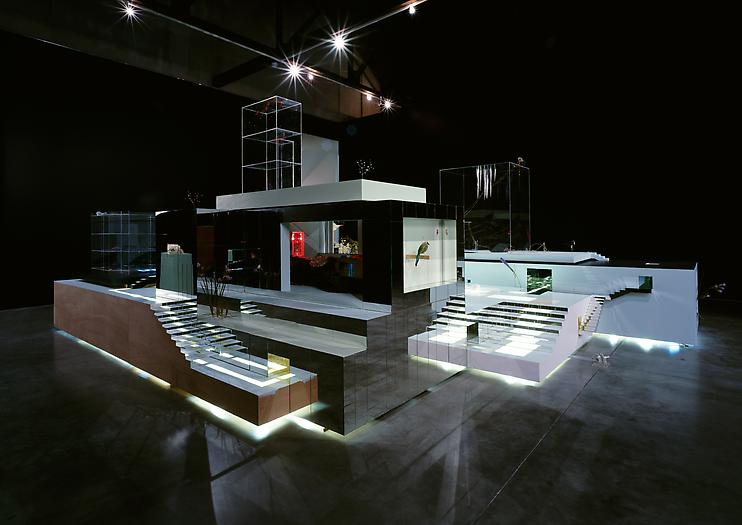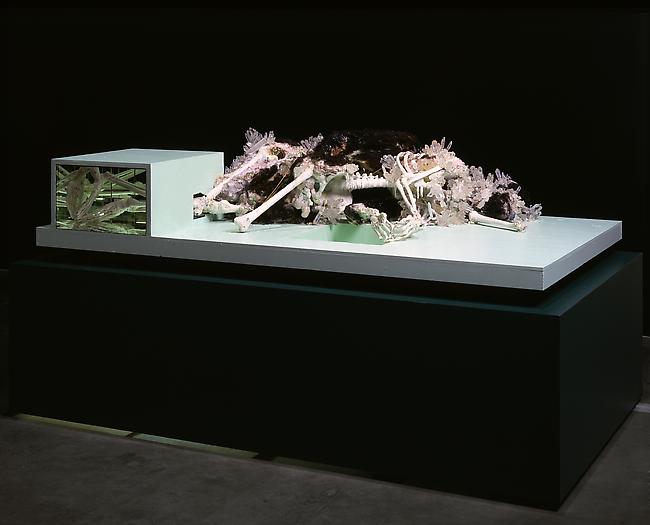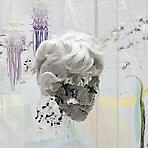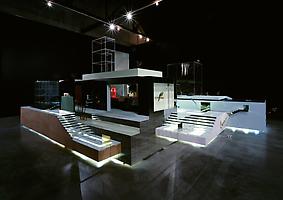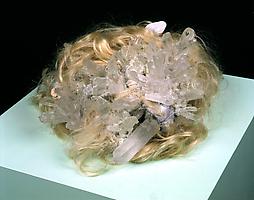David Altmejd
October 22 – November 27, 2004
Main Gallery
"Full fathom five thy father lies; Of his bones are coral made;
Those are pearls that were his eyes:
Nothing of him that doth fade
But doth suffer a sea-change
Into something rich and strange.
Sea-nymphs hourly ring his knell." -William Shakespeare
"It is intended to be alive. Maybe weird and dark, but certainly alive." -David Altmejd
Andrea Rosen gallery is proud to present David Altmejd's first solo exhibition with the gallery featuring three arresting new works.
Altmejd's work drips with decay. The flesh falls away from decomposing werewolves, exposing fragments of bone; their faces either in repose or contorted into a last silent anguished cry.
His sculptures though are less about death than the transition into something else, a transformation perhaps symbolized by the use of the werewolf as a recurrent motif, a creature that in myth painfully changes from man to animal. Entropy is not a corrosive force. Rather, Altmejd employs it as his muse.
The University, his largest and most ambitious sculpture to date uses the artist's distinctive vocabulary. In the piece, a labyrinth of multi-layered platforms and geometric shapes appears to have taken back the corpses like inorganic overgrowth. Mirrored tunnels, staircases and channels of light criss-crossing the work act as nervous systems connecting the whole and creating an energy that permeates the fantastical landscape. The creatures decay not into an organic mulch but calcify into crystals and jewels. Chains connect bones and other parts of the sculpture, a physical manifestation of the electricity that pulses through the work. Mirrored boxes refract the objects inside into infinity.
A Victorian gothic sensibility is tempered by contemporary pop culture. The work is festooned with gaudy jewels, glitter and plastic flowers, like the collection of some insane magpie. The grotesque and glamorous, romantic and geometric, organic and man-made are merged. The werewolves' heads are at once frightening and seductive. Birds and the flowers, both constants in the artist's work, overlay the tension in the piece with a strange sense of serenity.
A second piece shows two decaying creatures in a violent last grasp of lust, an eroticism that charges the work. A monster forces a bony finger into the behind of a werewolf. Again flesh rots but the effect is far from gory. Altmejd instead seems struck by a sense of wonder at the exposed workings of the body, the elegance of the spine and the hands, like illustrations in Gray's Anatomy.
Both works hint at a cryptic narrative. They are alive with creepy horror, similar to fairy tales before the sinister parts of the story were sanitized for modern ears. But they resist any one interpretation. It is the unresolved nature of the story and the symbolic potential of the works that invites fascination.
The third piece is the most abstract but hints at similar themes. A massive symmetrical and intricate network of mirrors, sucks in the world around it, fragments it, digests it, and reshapes it into something new. The sculpture is chiefly about the energy it creates and the concept of transformation. The piece interprets its surroundings, sorting them into its own logic and misshapen order, in much the same way that a viewer experiences the world.
Born in Montreal, Altmejd lives and works in Brooklyn, New York and graduated from Columbia University in 2001. His work was featured in this year's Whitney Biennial of American Art and in the Istanbul Biennial in Turkey.
David Altmejd
David Altmejd is known for his intricate and highly worked room-size installations and sculptures. Seamlessly moving between a variety of aesthetic modes – from an almost ascetic minimalism in works employing plaster and mirror to works teeming with accumulations of crystals, gold chain, thread, taxidermied birds and animals, among other objects -- Altmejd’s work offers beautifully wrought meditations on the cycles of life and death, interiority and exteriority, sexuality, and spirituality. In the most comprehensive consideration of the artist’s work to date, the volume includes four essays by a range of writers, who by providing different entry points to Altmejd’s art, animate and engage the rich and diverse ideas that characterize his important practice.
The full range of Altmejd’s nearly 20 years of work is featured in the book, from his earliest work--where the vast aesthetic vocabulary he has evolved over the years took shape--to his most recent series. Organized roughly chronologically, with an extensive art historical essay by Robert Hobbs as well as pithy contributions from the other esteemed writers forming the connective tissue between expansive sections of color plates, one can trace the many through-lines that the artist has developed and reworked during his career. The book affords a close and intimate view of the inspired and wholly unique work that brought him to prominence in the early 2000s, while also providing a sense of the breadth and scope of his polymath-like creativity and inventiveness in work less well-known or chronicled.
Edited by Isabel Venero
Format: Hardcover
9.5 x 11.75 inches / 384 pages
Language: English
Publisher: Damiani
2014
CONTRIBUTORS
Trinie Dalton is a writer of fiction and short stories, as well as being an accomplished art writer. Wide Eyed (Akashic), Sweet Tomb (Madras Press), and A Unicorn Is Born (Abrams) are works of fiction. Dear New Girl or Whatever Your Name Is (McSweeney’s) and Mythtym (Picturebox) are compilations of art writing. She has written articles for venues such as Bookforum, Paper, Purple, Arthur, The Believer, and Bomb. She teaches book/arts and writing at Pratt and NYU, and is on the MFA Fiction faculty at Vermont College of Fine Arts.
Christopher Glazek is a writer living in Los Angeles and the founder of the Yale AIDS Memorial Project. His essays focus on a range of social and cultural issues. Recent work has attended to complex problems such as the incarceration crisis, HIV/AIDS, credentialism, and student debt, in addition to critical writing devoted to art, film, literature, and music. His work has appeared in Artforum, the literary journal N+1, New York Magazine, The London Review of Books, and NewYorker.com, among other publications.
Robert Hobbs is an art historian at Virginia Commonwealth University, where he has held Rhoda Thalhimer Endowed Chair since 1991. He has also been a visiting professor at Yale University since 2004. Recognized as a scholar, teacher, and curator, Hobbs specializes in both late modern and post-modern art. He has published widely and has curated dozens of exhibitions at important institutions in the U.S. and abroad. His publications include monographs on Milton Avery, Alice Aycock, Edward Hopper, Lee Krasner, Mark Lombardi, Robert Smithson, and Kara Walker, and he has also written on Hernan Bas, Keith Haring, Jonathan Lasker, Mark Lindquist, Malcolm Morley, Neo Rauch, Andres Serrano, Yinka Shonibare, James Siena, Meredyth Sparks, and John Wesley.
Kevin McGarry is a writer, editor, and curator. He writes the contemporary art column “Out There” for T: The New York Times Style Magazine, is the art editor for V Magazine, and reviews exhibitions for Art Agenda and Artforum.com. He was the editor of the first monograph on Ryan Trecartin (Skira Rizzoli) and contributed to the major monograph on Yayoi Kusama published in 2012 (Rizzoli). He is a co-programmer of Migrating Forms, an annual festival of artists’ film and video at Anthology Film Archives, and in 2013, was the film curator for MoMA PS 1’s “Expo 1.”
David Altmejd
Published by Xavier Hufkens, Brussels, on the occassion of David Altmejd's 2013 exhibtion at the gallery.
ISBN 978-94-91245-05-3
David Altmejd: The Index
2007, 72 p., hardcover
Col. ill., 22 x 28,5 cm
© David Altmejd, Louise Déry and Galerie de l’UQAM
ISBN 978-2-920325-18-0
This publication accompanies the exhibition David Altmejd: The Index, organized by the Galerie de l’UQAM and presented in the Canadian Pavilion at the 2007 Venice Biennale. The catalogue includes an essay by Louise Déry about The Index, and The Giant 2. Its title refers to the principle of collection and of the diversity of species, to their classification, their organization into a dynamic avifauna, where an internal equilibrium ensures the perpetuity of the system, which somehow suggests a symbolic architectural modelling of life. This publication won an award in the 2008 Grafika competition.
Français / English / Italiano
David Altmejd
2006, 112 p., hardcover
Col. ill., 21,5 x 27 cm
© David Altmejd, Louise Déry and Galerie de l’UQAM
ISBN 2-920325-95-7
ISBN 978-2-920325-95-1
This publication is the first monograph dedicated to David Altmejd. It provides extensive visual documentation, particularly on the work The University 2, exhibited at Andrea Rosen Gallery in 2004 and acquired by the Guggenheim Museum in New York. The essay by Louise Déry surveys ten years of work and examines the major aspects of the artist’s research and of his oeuvre. This book was published to coincide with the travelling exhibition David Altmejd, organized by the Galerie de l’UQAM in 2007 and presented in Montreal (Galerie de l’UQAM), Oakville (Oakville Galleries) and Calgary (Illingworth Kerr Gallery, Alberta College of Art + Design).
Français / English
The University 1
2004
Mirror, wood, glue
66 x 71 x 106 inches (167.64 x 180.34 x 269.24 cm)
ARG# AD2004-012
The University 2
2004
wood, paint, plaster, resin, mirrored glass, Plexiglas, wire, glue, plastic, cloth, synthetic hair, jewelry, glitter, minerals, paper, beads, synthetic flowers, electricity, light bulbs.
107 x 215 x 252 inches (271.78 x 546.1 x 640.08 cm)
ARG# AD2004-013
Untitled
2004
wood, paint, plaster, resin, mirrored glass, plexiglas, wire, glue, plastic, fake hair, jewelry, glitter
h: 7 1/2 x w: 14 x d: 14 inches
ARG# AD2004-014
The Lovers
2004
Plaster, resin, paint, synthetic hair, jewelry, glitter, wood, lighting system, plexiglass, mirror
45 x 90 x 54 inches (114.3 x 228.6 x 137.16 cm)
ARG# AD2004-015

